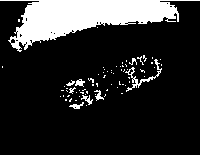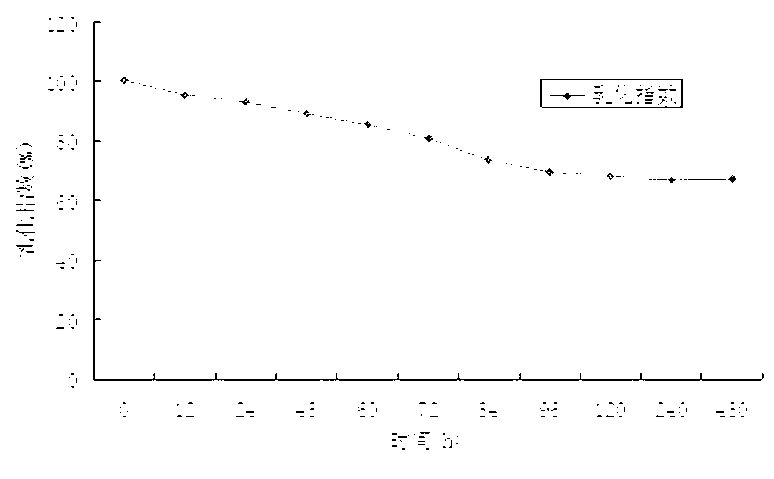Marine surfactant-producing bacterial strain LHOD-1 and application thereof
A technology for producing surfactants and oceans, applied in the field of microorganisms, can solve problems such as the hazards of breeding resources, hypoxia, and death of marine organisms, and achieve the effect of improving degradation efficiency
- Summary
- Abstract
- Description
- Claims
- Application Information
AI Technical Summary
Problems solved by technology
Method used
Image
Examples
Embodiment 1
[0018] Embodiment 1 The screening method of marine surfactant bacterial strain:
[0019] 1. Material preparation
[0020] 1. Bacterial source and experimental wastewater
[0021] (1) The bacterial source was the sediments at the scene of the 7.16 oil spill accident in Dalian City, Liaoning Province, which was polluted by petroleum hydrocarbons.
[0022] (2) Experimental waste water: 1000 mL of natural seawater, sterilized at 121 °C for 20 min, added 100 mg of diesel oil filtered through a 0.2 um microporous membrane.
[0023] 2. Medium
[0024] (1) Selection medium: 1000 mL of natural seawater, sterilized at 121 °C for 20 min, added 100 mg of diesel oil filtered through a 0.2 um microporous membrane.
[0025] (2) Separation medium: 5.0 g peptone, 1.0 g yeast extract, 0.1 g ferric phosphate, 1000 mL aged sea water, 20 g agar powder, pH 7.6-8.2, sterilized at 121 °C for 20 min.
[0026] (3) Activated expansion medium: peptone 5.0 g, yeast extract 1.0 g, ferric phosphate 0.1 ...
Embodiment 2
[0038] Example 2 Identification of marine surfactant-producing strain LHOD-1
[0039] 1. Identification of marine surfactant-producing strains
[0040] The physiological and biochemical identification and 16S rDNA molecular identification of the marine surfactant-producing halobacteria CGMCC 6715 were carried out, and the species of the strain was determined from the molecular level, combined with the analysis of the morphological characteristics and physiological and biochemical characteristics of the bacteria.
[0041] 16S rDNA sequence analysis mainly follows the following steps:
[0042] ① Extraction of bacterial nucleic acid DNA
[0043] Using TAKARA Bacterial Genomic DNA Extraction Kit to obtain the DNA of the strain
[0044] ②PCR amplification of 16S rDNA gene
[0045] P1: 27f (5'-AGA GTT TGA TCC TGG CTC AG-3')
[0046] P2: 1492r (5'-AAG TCG TAACAAGGT AAC C-3')
[0047] In a 50 uL system, add 1 uL template DNA (0.1 ug), 0.5 uL P1 and P2 (final concentration 0.5 uM)...
Embodiment 3
[0100] Example 3 Cell morphology, physiological and biochemical characteristics of marine surfactant-producing strain LHOD-1
[0101] See Table 2 for the physiological and biochemical characteristics of the marine surfactant-producing halobacteria CGMCC 6715, and see Table 2 for the cell morphology. figure 1 .
[0102] Table 2 Cell morphology, physiological and biochemical characteristics of the marine surfactant-producing strain LHOD-1
[0103]
[0104] Remarks: "+": more than 90% of the strains are positive; "-" more than 90% of the strains are negative.
PUM
 Login to View More
Login to View More Abstract
Description
Claims
Application Information
 Login to View More
Login to View More - R&D
- Intellectual Property
- Life Sciences
- Materials
- Tech Scout
- Unparalleled Data Quality
- Higher Quality Content
- 60% Fewer Hallucinations
Browse by: Latest US Patents, China's latest patents, Technical Efficacy Thesaurus, Application Domain, Technology Topic, Popular Technical Reports.
© 2025 PatSnap. All rights reserved.Legal|Privacy policy|Modern Slavery Act Transparency Statement|Sitemap|About US| Contact US: help@patsnap.com



